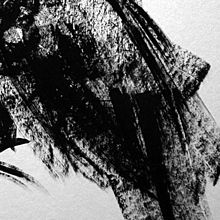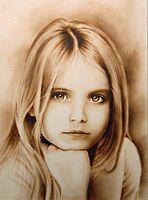Dry brushing
Dry brushing or dry painting is a painting technique in which only a small amount of paint is picked up with a dry brush in order to achieve a coarse brush stroke . The basic painting textures are particularly well highlighted.
Areas of application
In painting , this technique is mainly used in contemporary expressive painting styles in which acrylic paint is applied to a coarse painting surface. In principle, however, this painting technique can be implemented with all water- and oil-based paints. Especially when it comes to watercolors, one speaks of granulating .
In miniature and model making , this technology is often used on materials such as plastic or wood for the realistic representation of aging , e.g. B. worn metal or other materials are used.
For dry brushing, you take up some paint with a paintbrush, which you then wipe off on a cloth (paper or fabric) until there is only enough paint left on the paintbrush to emphasize the fine texture of the cloth. The remaining amount of paint on the brush is used to "brush" over the object to be painted or the painting surface. In the case of thin paints such as ink or watercolors, the brush is squeezed out after the paint has been picked up until it is almost dry before you start “brushing”. This technique of applying paint means that raised areas or edges are highlighted (because only these areas where paint will stick); The optical plasticity of objects is increased, and there is an effect of wear, soiling or aging. In painting, for example, light reflections can be represented by dry brushing and a lively impression is created.
The dry brush
origin
(: From the dry brush technique an independent Technique, in connection from oil to watercolor paper developed in a short period of dry brush Engl. : Dry brush ). The technique was created by the street painters in the mid-1980s on Arbat Street, the pedestrian zone in the historic heart of Moscow . There passers-by were portrayed, and with simple means in the shortest possible time. Usually this was done with pencil , charcoal or pastel chalk .
It soon became apparent that painting with the dry brush was perfect for portraying, and that is why it quickly became popular with many street painters. The technology enables fast, high quality drawing. It is possible to work directly from start to finish without a pencil sketch. This makes the painting process particularly fast and fascinating for the viewer.
However, you can also start with a preliminary drawing and then continue painting with a dry brush using the technique. The proportions are already determined with a preliminary drawing and a certain degree of security for image processing is guaranteed. Pictures, painted with a dry brush, are characterized by the special transitions of light and shadow and extremely delicate tones.
In the meantime the technology has become known, but much more so in Russia than in other countries. Even if this technique was originally only used for portrait painting, it has meanwhile turned out that it is also very suitable for other motifs.
- Dry brush technique
Basics
Only a small amount of oil paint is required for painting with a dry brush. The paint is diluted with a few drops of linseed oil. Very little paint is picked up on the brush. Then the brush is rubbed with the paint on the palette to remove the oil from the brush again. The brush must stay dry at the end. A very thin layer of paint is applied to watercolor paper with the brush. After that, it is possible to use an eraser to make various erasures for lighting effects and details.
Finally, the work in black and white looks similar to a charcoal or fine pencil drawing. The paint layer can no longer be smeared or removed. Nevertheless, the work has to be kept under a glass frame because of the sensitive paper.
literature
- Nadja Sasch: The dry brush. Edition Michael Fischer, Ingling 2012, ISBN 978-3-86355-085-1 .
Web links
- An explanation of this technique on: plastikmodell.de




